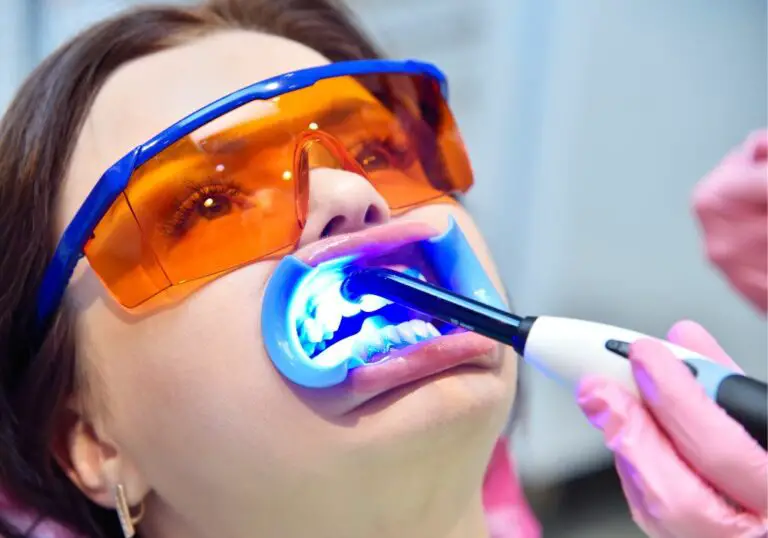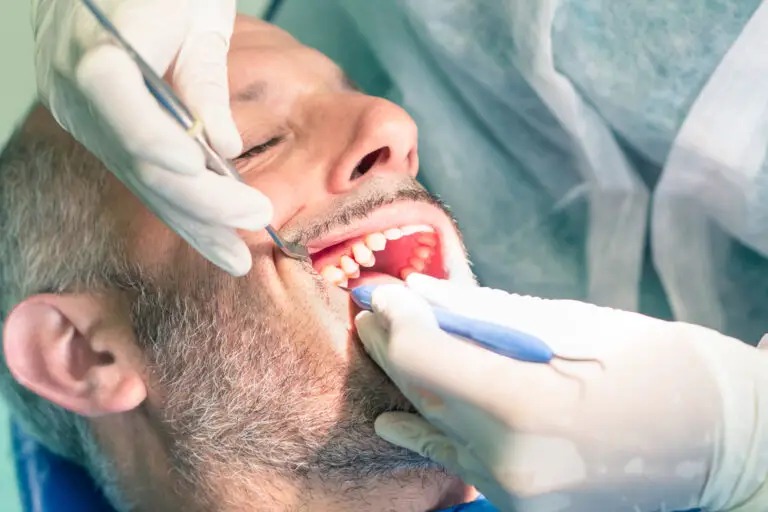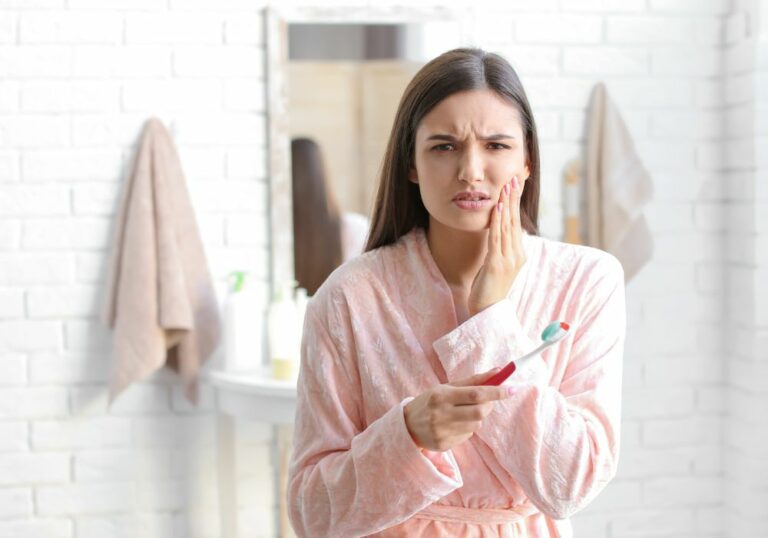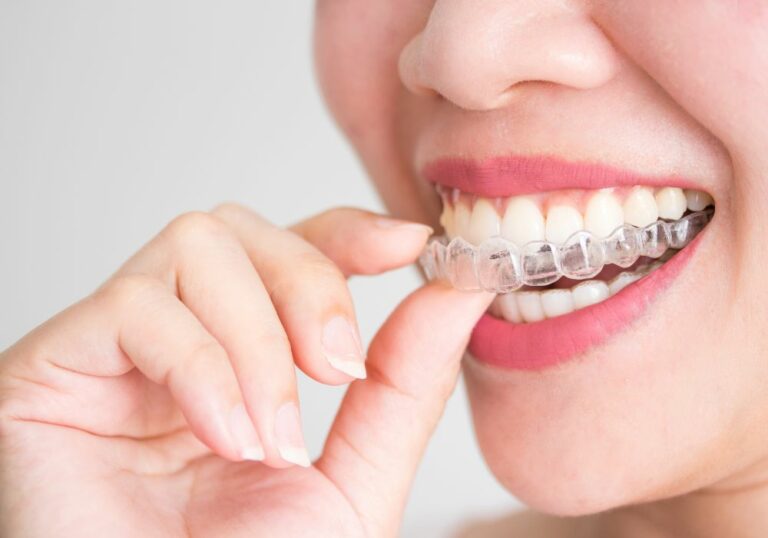Having teeth knocked loose or shoved out of position can be an alarming experience. Your first instinct may be to try pushing them back into proper alignment with your fingers. However, this is not advisable. Teeth are complex structures that can be permanently damaged by improper manipulation. In this comprehensive article, we will explore whether you should attempt repositioning teeth yourself, look at risks and complications, discuss better alternatives, and provide tips for handling dental emergencies properly.
Dangers of pushing teeth yourself

While it may seem sensible to try pushing teeth back in place, this can lead to significant oral health problems. Here’s why it’s not a good idea:
High risk of further damage
Teeth contain living tissues including the tooth pulp, nerves, and blood vessels inside the hard enamel and dentin. Pushing too forcefully on a tooth can crush these delicate inner components, killing the tooth pulp and causing devitalization where the tooth loses sensation and vitality.
The periodontal ligaments anchoring the tooth root can also suffer damage or tearing. This destabilizes the tooth, causing increased mobility and eventual tooth loss if the ligament rupture is severe enough. Attempting to push teeth can even sometimes dislodge them entirely out of the socket.
Loss of supporting bone
The bony socket housing the tooth root is also at risk of damage from excessive pushing or improper force angles. Crestal bone loss and destruction of the lamina dura surrounding the tooth can occur, which compromises the tooth’s anchorage and health.
Infection risks
Any chips or cracks to the tooth enamel provide openings for bacteria to invade and infect the interior pulp. Pushing can expose dentinal tubules and pulp chamber, increasing the chance of painful dental abscesses and infection spreading down the root which may require root canal therapy or extraction.
Incorrectly positioned teeth
It is difficult to ensure proper tooth placement and angulation when trying to reposition by hand and eye. Without dental x-rays to visualize roots and bone, teeth may be shoved into improper alignment leading to a poor bite (malocclusion).
Additional dental fractures
The force applied by fingers can cause further cracking or fragmentation of already damaged teeth or adjacent healthy teeth. Chipped areas may be pushed deeper toward the pulp.
Soft tissue injury
Pressing tightly on tissues to move teeth can bruise, tear or penetrate the gum or lip lining. This increases sensitivity and can be an entry point for bacteria.
Aspiration/swallowing risk
Teeth or fragments can be accidentally inhaled or swallowed if propelled backward in the mouth. This causes a choking hazard and requires immediate medical assistance.
Due to the high probability of adverse outcomes, dentists strongly advise against patients attempting to reposition teeth themselves by pushing with fingers. Proper repositioning requires professional tools, training and techniques.
Better and safer alternatives
While you should avoid pushing on teeth, there are some appropriate things you can do to temporarily manage the situation:
Pain management
Over-the-counter pain relievers like ibuprofen or acetaminophen can provide relief until a dental visit. This may help reduce swelling and discomfort. Avoid using aspirin directly on the gums which can burn and cause irritation.
Cold compresses
Gently holding a cold compress externally against the cheek can help minimize swelling and inflammation. Do not apply ice directly on the teeth.
Soft diet
Stick to a soft lukewarm diet and avoid very hot or very cold foods. Stay away from crunchy, chewy, sticky foods that could further aggravate the injured teeth.
Dental wax
Apply orthodontic wax or dental adhesive over sharp teeth edges to minimize damage to the tongue and lips. Try to avoid getting wax debris stuck in the exposed tooth.
Temporary filling
Use a tooth cavity filling product from a pharmacy to lightly fill any cracks or gaps as a short-term barrier. Monitor for washout and avoid using superglue/household adhesives not designed for dental use.
Proper oral hygiene
Gently clean teeth and mouth to avoid food buildup in injured areas. Use a soft brush and non-alcohol mouthwash until you can have a dentist truly clean and assess the teeth.
Emergency dental care
Most importantly, promptly visit an emergency dentist to have the teeth properly repositioned, splinted, and restored. This gives the best chance of saving injured teeth and avoiding complications. Do NOT delay.
Risks and complications

Attempting to do-it-yourself tooth repositioning can lead to both immediate problems and long-term oral health consequences:
Immediate risks
- Severe tooth fracture resulting in tooth loss
- Devitalization and nerve damage requiring root canal
- Luxation injuries and displacement of the tooth root
- Broken or shattered tooth crown and enamel
- Avulsed (knocked out) tooth that cannot be saved
- Tearing of the gingiva (gums) and periodontal ligament
- Inability to properly close jaw due to misaligned bite
Long-term complications
- Tooth loss leading to missing teeth, gaps, and need for prosthetic replacement
- Altered tooth alignment affecting chewing and causing TMJ disorders
- Progressive gum recession or pockets around the tooth
- Increased susceptibility to tooth decay and fractures
- Aesthetic changes from chipped enamel or loss of tooth structure
- Eventual need for dental implants or bridges to replace severely damaged teeth
Seeking prompt professional treatment minimizes the likelihood of permanent tooth damage or loss.
When are teeth too severely damaged to save?
While most mildly displaced or loosened teeth can be successfully reimplanted and splinted by a dentist, severely traumatic injuries may preclude repair in some cases. Some dental injuries that have poorer prognosis include:
- Vertical root fractures extending into the bone
- Shatters, splits or fractures involving more than a quarter of the tooth
- Severe mobility indicating extensive periodontal ligament damage
- Complete avulsion out of the socket for over 60 minutes
- Signs of pulp necrosis (tooth devitalization) such as grayish discoloration
Extraction may be required if the tooth is deemed non-restorable or non-viable. Options to replace the missing tooth include dental implants, bridges, partials, or dentures. Proper handling of fractured teeth can still help preserve some of the remaining tooth structure.
How to properly handle knocked out permanent teeth

Follow these steps for an adult tooth that has been completely knocked out of the socket:
Step 1: Find the tooth
Gently pick up the tooth by the white enamel crown portion rather than the sensitive root area. Be careful not to damage the root or any periodontal ligament fibers still attached.
Step 2: Rinse briefly
Hold the tooth by crown and lightly rinse under cool water to remove visible dirt and debris. Do not scrub vigorously.
Step 3: Try to reinsert
If you can easily place the tooth back into the socket without force, do so. Have the person bite down gently to hold it in place until seeing a dentist. The tooth may reattach on its own.
Step 4: If not possible, place in interim storage
If the tooth won’t sit back in place, store it in a container of milk, saliva (spit), or sterile saline solution. Place the tooth with the root tip down. Avoid water which isn’t ideal for preserving cells.
Step 5: Get emergency dental treatment ASAP
See an emergency dentist immediately to have the best chance of reimplantation. Time is critical for viability, so don’t delay.
Following proper steps can optimize the tooth’s chance of reattachment and survival rather than further damaging it.
Can displaced baby teeth be put back in place?
Primary or baby teeth that have been intruded, extruded, or laterally luxated should also not be pushed on. Their shallower roots and developmental stage make them susceptible to damage. However, dentists may try to reposition and stabilize severely loosened or upwardly displaced primary teeth to preserve the space. Otherwise they will likely allow the tooth to naturally exfoliate if very mobile and wait for the permanent tooth to erupt. Parents should still seek dental evaluation for injuries to primary teeth.
When is urgent dental care absolutely necessary?
Prompt emergency dental care within hours is critical for teeth that exhibit:
- New-onset sensitivity or pain, which may indicate pulp involvement
- Visible cracks, fractures, or pieces breaking off
- Major loosening, shifting or recessing into the gums
- Protrusion or extrusion partially out of the socket
- Knocked out completely (avulsion)
- Inability to move the tooth into its original position using very light finger pressure
Leaving significantly displaced or traumatically damaged teeth without professional treatment can have poor outcomes. Don’t take a “wait and see” approach.
Frequently asked questions
Here are some common FAQs about troubled teeth:
Q: My front tooth feels slightly loose after getting hit. Should I try pushing it back into place?
Never use more than extremely gentle pressure with fingers on teeth. Any loosening or change warrants urgent dental exam for proper repositioning and stabilization.
Q: Can I superglue a broken chunk of tooth back on?
No. Reattaching fractured dental fragments requires professional bonding material and technique to match shape and restore form and function.
Q: How long can a knocked-out adult tooth be saved after being replanted?
Best prognosis is within 30 minutes. Still possible within 1-2 hours if properly handled. After 2+ hours viability decreases but reimplanting may help preserve bone contour.
Q: Is a primary baby tooth likely to survive if knocked out?
Unlike permanent teeth, avulsed primary teeth have a poor survival prognosis so preserving the empty space for the permanent tooth may be the priority.
Q: My tooth turned gray at the root after being hit. Can it be saved?
Unfortunately, grayish discoloration signifies pulp necrosis and the tooth is likely non-viable. A root canal or extraction may now be required.
Conclusion
Teeth are highly vulnerable to permanent complications and damage if displaced and pushed on incorrectly. Getting teeth properly repositioned as soon as possible by a dentist is crucial. With prompt care, many injured teeth can be restored and saved. Avoid further problems by keeping your fingers away from significantly loosened or traumatized teeth and consulting a dentist immediately. With the right emergency treatment, your teeth and smile can be preserved.







